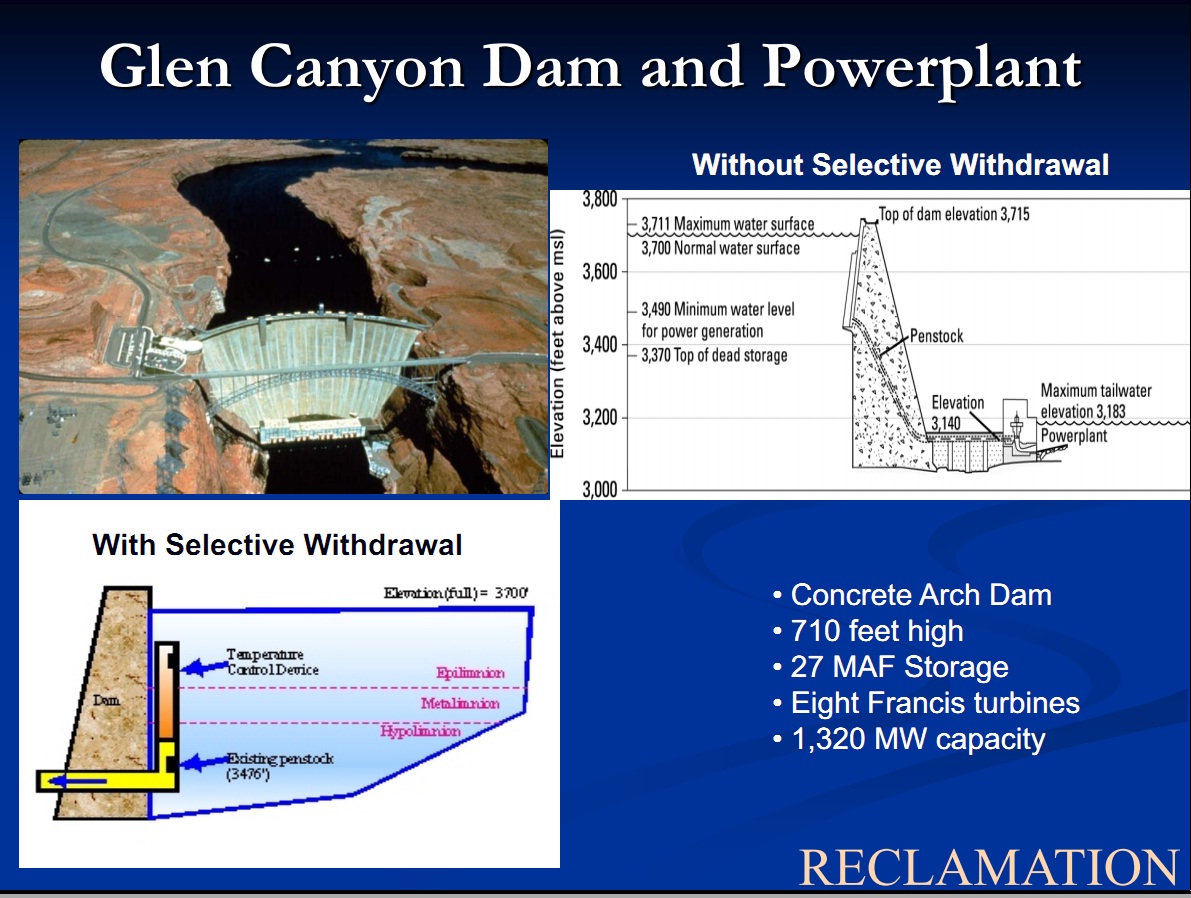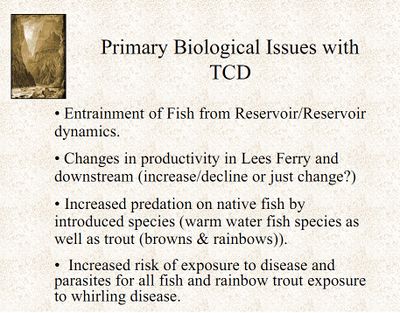Thermal Curtain
Examples: Whiskeytown Reservoir, Lewiston Reservoir
A thermal curtain is a type of selective withdrawal structure that can be installed on existing facilities without interrupting operations. Depending on how a thermal curtain is configured, they can be used to either increase or decrease release temperatures. The thermal curtain is constructed of a non-permeable material that is installed in the forebay of a reservoir. If cooler release temperatures are desired, the thermal curtain is configured to extend from the water’s surface down to the thermocline. This blocks the warmer, surface water from entering the dam’s intakes and being released downstream. If warmer release temperatures are desired, the thermal curtain is configured to extend from the thermocline down to the bottom of the reservoir. This blocks the colder, sub-surface water from entering the dam’s intakes and being released downstream. Thermal curtains can also be configured to cool water temperatures in the dam’s forebay to create a behavioral barrier to warmwater fish entrainment through the dam. Behavioral barriers are generally considered more effective than mechanical barriers (i.e. screens, nets, electrical fields, etc.) in reducing fish entrainment. Thermal curtains have been successfully deployed in both warm-water and cold-water configurations. Initial modeling has suggested a thermal curtain installed at Glen Canyon Dam could reduce water temperatures in the forebay and lower release temperatures enough to reach downstream temperature targets without the need of bypass. This potentially resolves issues associated with reduced hydropower generation and impacts to the Basin Fund, which is needed to fund the operations and maintenance of the CRSP system, while also reducing warm-water fish entrainment and providing increased control of release temperatures to meet downstream biological goals.
Selective Withdrawal Structure
Examples: Flaming Gorge Dam, Shasta Dam
A selective temperature withdrawal system is a rigid steel structures on the upstream face of the dam to enclose the penstock intakes (Svoboda 2020). Selective temperature withdrawal systems can be new external-frame structures that are attached to the dam or retrofit modifications to existing dam features, such as adding gates to the trash rack structure around the penstock intakes (Svoboda 2020). A previous selective temperature withdrawal system has been considered for the Glen Canyon Dam in the early 2007-2008 (Vermeyen 2011). Earlier proposals for the selective temperature withdrawal system were focused on warming downstream releases but the design was never finished.
Destratification: (Bubblers, Pumps, etc.)
Mixing thermal strata in the GCD forebay that results in substantial cooling during times of otherwise warm water releases (typically summer through fall) is likely to reduce or eliminate smallmouth bass spawning in the mainstem Colorado River below the dam. Also, mixing thermal strata in the GCD forebay and cooling the water would likely reduce the number of warmwater nonnative fish present in the forebay, including smallmouth bass. Smallmouth bass would likely move out of the area to seek warmer waters (Carter et al., 2012) such as the shallow, littoral habitat found in nearby Wahweap Bay.
Floating Pumping Platform or Trunnion Cold Water Withdrawal
Two different modifications are being suggested as direct piping of cold water to the intake. One proposed solution came from a 2020 technology search by yet2 sponsored by the Bureau of Reclamation focused on new technologies to control water temperature of reservoir release flows. This proposed solution would be a floating pumping platform that could be placed into the forebay to pump water at a fixed or variable water depth directly to the intake of the penstock (Makai Ocean Engineering; Figure 1). Difference variations for this model could range from several pumping stations suppling cold water to the penstocks or only a selective few of penstocks. A second proposed solution would be Trunnion cold water withdrawal. The idea behind this system is that a pipe is hinged and sealed at the intake to bring in cold water (Sherman 2000; Figure 2). For both suggestions, the theory is that enough cold water could be mixed in the penstock to reduce temperatures discharging from the dam.
Bypass
This is a continuation of current operations at Glen Canyon Dam (GCD) developed as part of the Smallmouth Bass Supplemental Environmental Impact Statement (SEIS). The SEIS was finalized in June of 2024 and the Record of Decision was signed and implemented in July 2024. There are 5 possible options for GCD releases to keep water temperatures at river mile 61 in Grand Canyon at or below 15.5°C. For a more complete summary and discussion of flow alternatives, please refer to the Final SEIS (Bureau of Reclamation, 2024).
The total bypassed volume to date (July 9 - 18, 2024) is approximately 150,000 acre-feet or ~30% of the total daily release volume. Approximately 1°C of cooling is being observed at Lees Ferry (RM 0). Full effects of bypass at RM61 are still being evaluated. Water temperatures at RM 61 are estimated to remain over the 15.5°C threshold until November 1 and thus, bypass would be required for most of the summer and fall, a period of 16 weeks.
The SEIS estimated an average hydropower impact from the Cool Mix alternative of $61.73 million (226.29 GWh) over a 45-month period (tables 3-12 and 3-17 in Bureau of Reclamation, 2024). Bypassed water does not produce hydropower and replacement costs are estimated to be ~$1 to $2 million per week (WAPA 2024, personal communication). Observed costs are tracking estimates presented in the SEIS.
| 
